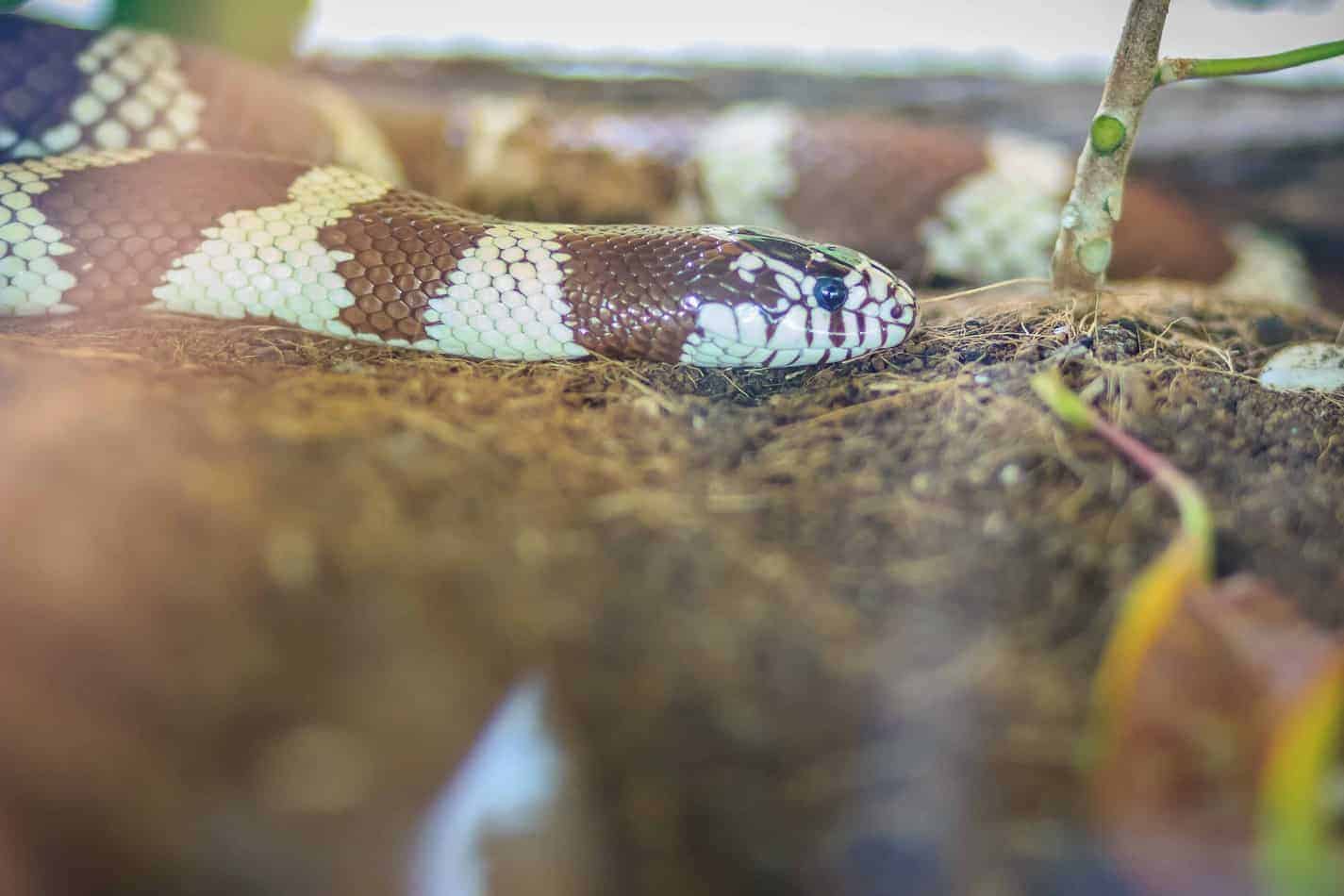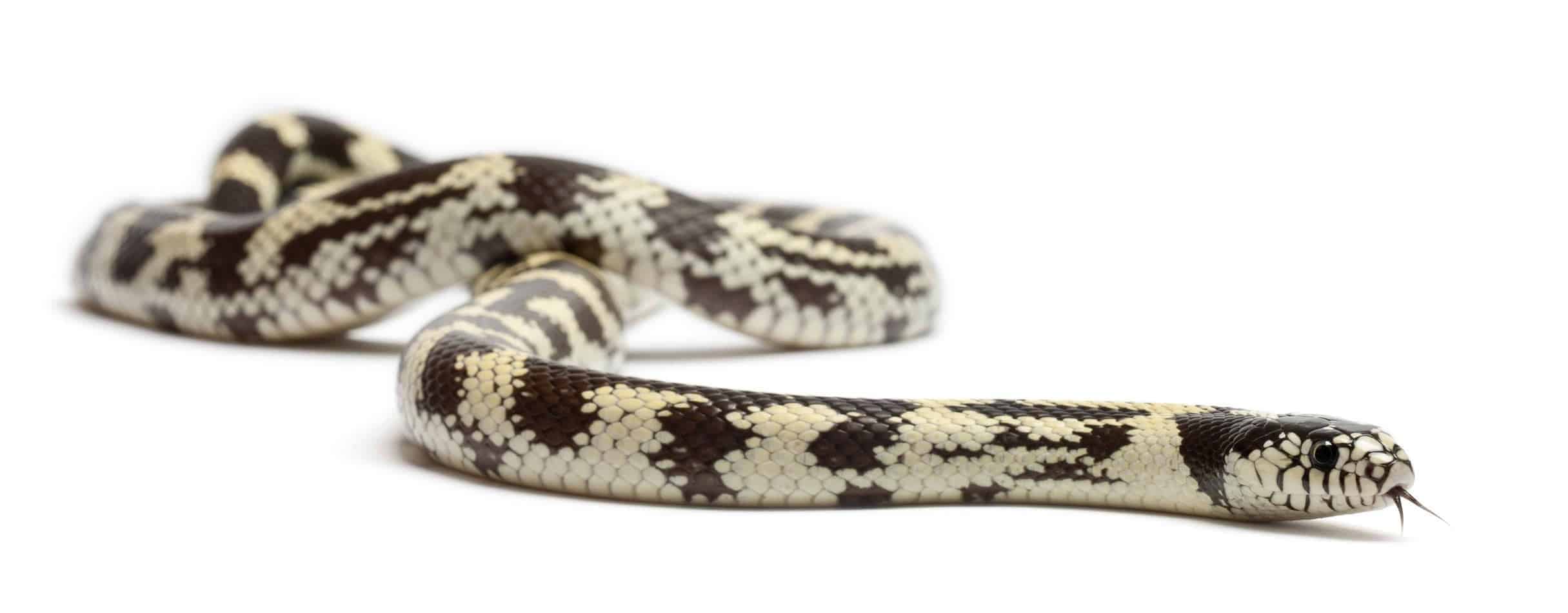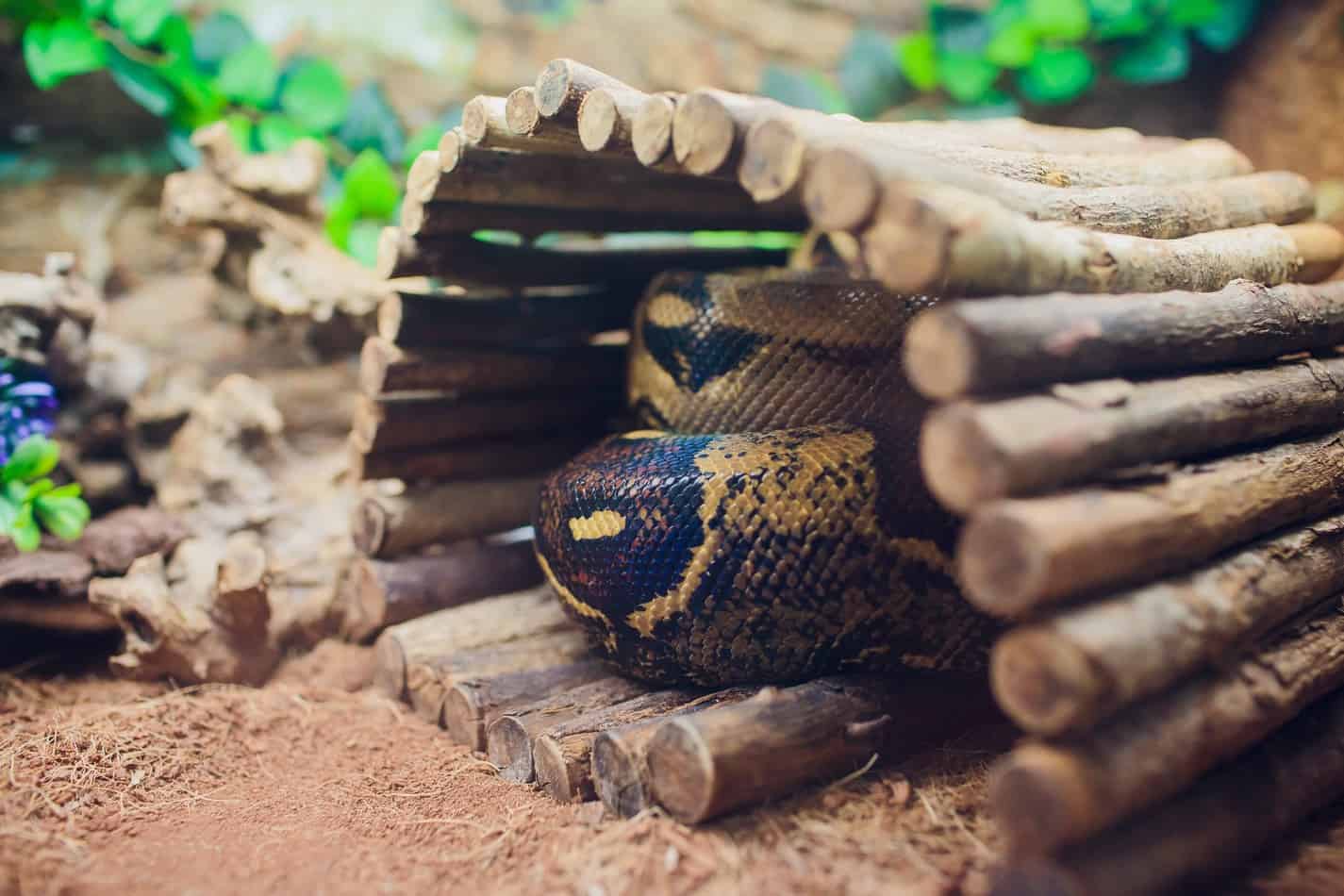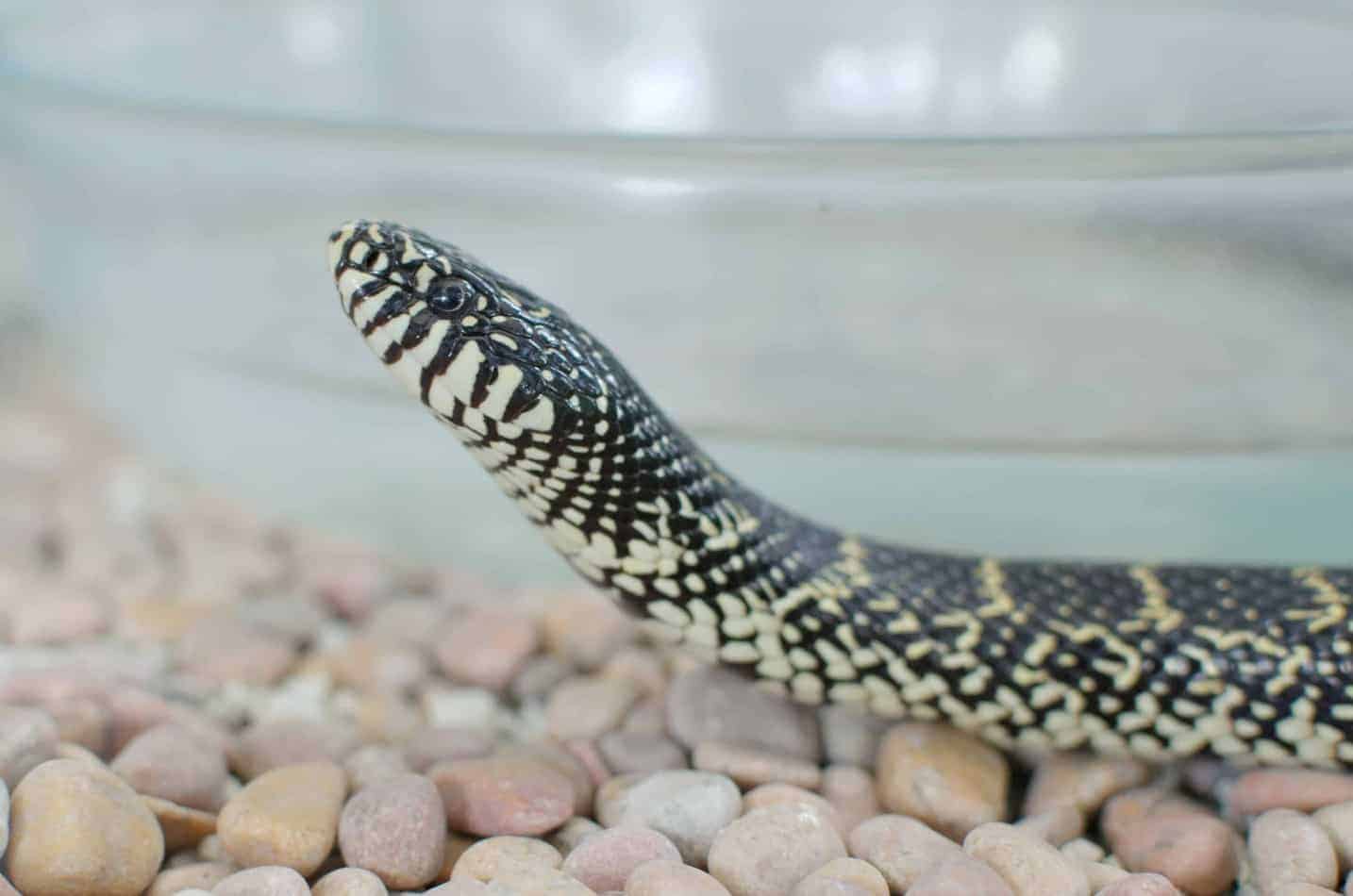Kingsnakes as Pets: A Complete Guide With Pictures
A kingsnake is completely different from “the King Snake”, which I was very disappointed to realize as I was going about my daily “googling run.”
Anyway, the King Snake was what I was trying to research (because I love comics possibly too much for my own good), but instead of websites detailing the backstory of this particular DC villain, all I got were Wikipedia pages about snakes. This is the one instance capitalization has actually mattered in a Google search bar.
I realized that kingsnakes (without space between those words) are actually pretty nifty. Here are a few tips I picked up about keeping them as pets.
King Snakes As Pets?
What do you need to know about keeping kingsnakes as pets? Kingsnakes are nonvenomous snakes which are popular to keep as pets. They will generally live about 20 years in captivity and eat thawed, pre-killed mice. They grow up to six feet long and are essentially harmless.
If you want to learn more about these “kings” among snakes, feel free to read on and learn everything there is to know about these guys.
The Kingsnake Backstory
Kingsnakes are one of the most common and popular snakes in the United States of America.
Rather than seclude themselves exclusively in the Land of the Free, kingsnakes have extended north into the Land of the Geese and south into the Land of the Best Food You’ll Ever Eat.
They prefer forests, grasslands, and rocky areas. They are nonvenomous, which, in and of itself, makes them significantly less frightening.
To add to that, however, is the fact that kingsnakes are also purely terrestrial, meaning they don’t climb trees or swim around in rivers or lakes.
They are nocturnal and spend a lot of their time hiding under logs and rocks, much like your average blogger (just substitute the log for a blanket, and you’ve got a direct match).
Their legal name is Lampropeltis
This is a reference to the kingsnake’s shiny and smooth dorsal scales. Personally, I prefer nicknames, so I’m just going to stick with “kingsnake” for now.
The taxonomy for kingsnakes was actually pretty difficult for scientists to come to a conclusion about. Previously, genus and species were determined by physical similarity and whether or not they could reproduce.
Now, however, with advances in science and technology, the DNA of each snake can be examined, and snakes that share a similar evolutionary path are grouped together.
It takes time to make changes, so the science of taxonomy, especially for snakes, has just been in a general state of upheaval for the past little bit.
The second problem specifically with the taxonomy kingsnakes lies in the disagreement on what morphs are a species and which are a subspecies.
There is a lot of hybridization between kingsnakes and other snakes that live in habitats in close proximity to kingsnakes, which makes it even more difficult to determine which ones belong in the same species and which ones don’t.
Right now, the taxonomy has landed on Lampropeltis elapsoides but that title is subject to change anytime. Who knows?
The coloring of kingsnakes is famous for its similarity to the coloring of the venomous coral snake. The ground color is typically red, with black and yellow bands. The coral snake is the opposite, with a black ground color and yellow and red bands.
Here is an example of a kingsnake’s coloring:

Desert Kingsnake, a subspecies of kingsnake native to Texas, Arizona, and New Mexico
This is the venomous coral snake. You get an idea of the difference in coloration and pattern, although it can vary from snake to snake:
Kingsnakes also tend to have skinnier bands than coral snakes. This similarity between a nonvenomous snake and a venomous snake is called mimicry. If a predator sees a snake that looks venomous, they’ll give the meal a pass.
The best way to remember the difference is “If red touches black, you’re okay Jack. If red touches yellow, you’re a dead fellow.”
“If red touches black, you’re okay Jack. If red touches yellow, you’re a dead fellow.”
This rhyme will only work in North America. Coral snakes outside of this continent are often completely different colors, and often even lack bands. This change in color actually isn’t that uncommon. Even different kingsnakes in different areas of the United States sport different colors and patterns.
Kingsnakes grow up to six feet, although the scarlet kingsnake, the most common one (the one with the similar coloring to coral snakes), usually grows to only two feet.
They have a spoon-shaped head, smooth scales (remember that “shiny shield” factoid from earlier?), and round pupils (this trait is constant in every nonvenomous snake).
While these snakes may mimic the venomous and aggressive coral snakes, here is what these friendly little reptiles are really like.
Temperament of Kingsnakes

A banana Eastern kingsnake, or common kingsnake ( lampropeltis getula californiae)
It may not come as a shock to you, but kingsnakes are wild animals–in all senses of the word. They have wild instincts that lead them to hunt, sleep, bite, and just explore. This wild attitude can carry over to captive kingsnakes.
Of course, the overall temperament of your pet kingsnake will really depend on your snake individually. This is akin to one of your dogs always bouncing off the wall while the other does nothing but sleep in the sun. Animals, even snakes, develop unique personalities.
Kingsnakes are a little more defensive than you might be used to pet snakes being. When threatened, they will emit a horrible smelling musk, much like a skunk. You definitely do not want them going off in your bedroom.
They will also shake their tails, which is another example of mimicry. They’re trying to copy the rattle of a rattlesnake’s tail in order to scare off would-be predators (i.e. you).
Even though kingsnakes are known for being snappier than most small nonvenomous snakes, they are still extremely popular pets. When proper handling is done often, kingsnakes can be tamed fairly easily.
A hand over hand movement, staying away from their face, is the ideal method of handling. Don’t handle them after they’ve eaten for a couple of days (so they can digest properly), or while their shedding. You’ll know that your snake is about to shed if their eyes turn milky or blue.
If you have a snake that fell into your hands straight out of the wild, start with handling them just once every several days, then feel free to ramp it up a little bit. They’ll get used to you and be tame in no time. Once they’re tame, kingsnakes are docile for the rest of their lives.
Breeding Kingsnakes: A Quick Guide
Kingsnakes can live into their 20’s if they are healthy and cared for properly, and they remain fertile into their early teens. Males and females both will reach sexual maturity between two and four years old.
The yearly mating season for kingsnakes is, on average, from March to August. This can depend on where in particular the kingsnake lives. They will mate earlier or later based on whether the weather is warmer or colder at that time of year.
The female kingsnakes lay clutches of eggs ranging from three to twenty-four in number. She will leave them somewhere hidden and moist, like a rotting log, and let them fend for themselves.
The eggs take roughly two to three months to hatch, and the hatchlings are about a foot long. They are born with all the instincts they need in order to survive. Females often lay more than one clutch of eggs during each mating season.
Males will mate with as many females as possible during the mating season. Females release a chemical scent for the males to follow. If two males come upon the same female at the same time, they will fight it out by wrestling until one of their heads lie flat on the ground, and the winner gets to mate with the female in question.
Curious about some of the morphs that are possible from breeding kingsnakes? Below you can find a list of many of their possible morphs.
A List of Kingsnake Morphs
As I mentioned before, there is a fairly heated debate over which types of kingsnakes are separate species, morphs, or subspecies.
In a nutshell, a species is the largest group in the population, a subspecies is just a smaller group within that big group that can successfully reproduce with other subspecies (but typically don’t due to geographical isolation), and a morph is a variety of a species that is specifically bred for a certain color or pattern. Morphs are the kind of snakes you will be purchasing in a store to keep as a pet.
The most common and popular morphs of kingsnakes are listed below. There is a pretty large market for snake breeders because people want their pets to look aesthetic, for some reason.
There are huge studies that go into the different traits of different morphs and what probabilities you can get from breeding two different subspecies.
Popular Kingsnake Morphs:
Banana High white Twin dotted Twin striped Reverse striped Reverse dotted Reverse wide stripe Vanishing stripe Charcoal back Mosaic Mojave 50/50 Aztec | Carpet Half and half Pin striped Hypermelanistic Chocolate Blizzard Joker Purple passion Lavender snow Chocolate banana Anerythristic Axanthic | Platinum Palomar ghost Dark phase ghost Light phase ghost Caspar ghost Pink pearl ghost Coral ghost Sapphire ghost Mosaic Palomar Ghost Het Palomar ghost Chocolate ghost |
You will want to get a snake that was captive-bred, as that lowers the possibility that your snake will have parasites and other diseases. This will also most likely result in an already docile kingsnake.
Many pet stores do not have the best selection of snakes, either because they just don’t have them, or because they often carry unhealthy snakes.
Instead, go to a breeder that you trust. A breeder will provide the genetic pedigree of your snake and your snake will be healthy and established (used to feeding on rodents).
Another option is to adopt a snake. This allows a snake to get a home where before it hadn’t been taken care of properly.
Besides a breeder and a pet shop, there are many online reptile stores and snakes are always available for purchase at reptile shows. Always read reviews on breeders and examine your snake before you buy it.
Unfortunately, despite how much I want to believe otherwise, sometimes people are just dishonest. Don’t let yourself get ripped off. Do your research on the pet shows and snake breeders near you to make sure the snake you get is not mishandled, smuggled in, diseased, or aggressive.
Next up: what a kingsnake eats.
What’s for Dinner: The Kingsnake’s Varied Diet

A Mexican black kingsnake eating a dead rodent
Kingsnakes are called “opportunistic eaters”. This means they’ll eat whenever, where ever, and whatever they can. In the wild, this is a good thing, but in captivity, not so much.
Kingsnakes actually have the highest rate of obesity among pet snakes. When your snake is maturing, feed them twice a week. Once they’re grown, reduce it to once a week. No more, no less.
With opportunistic eating comes a large and varied diet. Kingsnakes will eat any or the following and then some:
- rodents
- birds
- bird eggs
- frogs
- turtle eggs
- lizards
- other snakes
That’s correct, you read that right. Kingsnakes eat other snakes, even venomous ones. Did you kind of wonder where they got the name “King” from?
Kingsnakes are immune to the venom in other snakes and will eat rattlesnakes and cottonmouths. Of course, because they’re not picky, they will also go for rat snakes, garter snakes, and even their fellow kingsnakes.
Kingsnakes kill their prey by the method of constriction. Contrary to popular belief, that does not mean that they break all the bones in their prey’s body, nor do they suffocate their prey.
Constrictors squeeze their prey so hard, that they stop the blood flow to essential organs like the heart and brain, and their prey dies within seconds from ischemia.
Out of every species of snakes, kingsnakes actually have the strongest “squeeze.” They can deliver twice the constriction force (relative to body size) as rat snakes and pythons.
This is likely due to their strange choice in cuisine. It is a lot easier to squeeze a mouse than a snake. Because snakes are so much thinner and longer, it requires a much tighter squeeze to kill them.
Kingsnakes actively hunt their prey, as opposed to some snakes, like cottonmouths, that ambush their prey. Kingsnakes will track down their prey through their scent, latch onto them with their mouth, and start constricting.
In captivity, it is best to feed your snakes rodents. Kingsnakes prefer live prey, but you might want to avoid that, as live prey has a tendency to injure pet snakes or make them have aggressive bursts of behavior.
Out of every species of snakes, kingsnakes actually have the strongest “squeeze.” They can deliver twice the constriction force (relative to body size) as rat snakes and pythons.
I recommend either completely thawing a frozen mouse or giving your kingsnake a freshly killed mouse. I doubt you really want to be killing mice every week, so just stick to buying pre-killed mice in bulk and freezing them until they are needed.
Adult kingsnakes eat about once every week. Make sure to thaw a rodent completely before feeding it to your kingsnake. Otherwise, they’ll know it isn’t “fresh meat” and they might become picky eaters.
Housing Your Pet Kingsnake
Adult kingsnakes need, on average, a 20-gallon tank in order to give them enough room to move about. This tank will need to be tight, meaning there can’t be any openings through which your snake can escape.
Here is a cost-efficient 20-gallon snake tank I found on Amazon that would work great for a kingsnake.
Snakes are expert escape artists, so they will find gaps and make a break for it. Double check everything, and if you have any doubts on whether or not a certain tank will be secure enough, just be safe and don’t get it.
There needs to be a good substrate or lining. Kingsnakes like to burrow, so a lot of loose substrates would be ideal. For example, this aspen bedding is a great option for kingsnakes, as it is not as bulky as wood chips and is a cheap option that works great.
Don’t get any chemically processed material or any oily wood. Newspapers are a good choice, although it doesn’t allow the snakes to burrow. It’s just cheaper and much simpler to clean up and change. Kiln-dried pine shavings are among the top choices of herpetologists for substrates.
Change out the substrate often to keep the enclosure clean, reduce any bad smells, and keep your pet kingsnake healthy. This also goes for other snake species.
Include one or two hide boxes or houses for your snake. They like to burrow and hide under rocks and logs in the wild, so they’ll need some places to hide.
The hide boxes should be big enough for your snake to be able to completely curl up under, but not much bigger, or the snake won’t feel safe enough. Include one on the warm side of the tank and one on the cold side of the tank.
Kingsnakes are cold-blooded, so instead of their body regulating their internal temperature naturally, they regulate it by moving between places with different temperatures.
One side of your tank should be about 85 degrees Fahrenheit (warmer and known as the “basking” side), and the other side should be closer to the 70-degree mark.
You can achieve these temperatures with a heating lamp, but that is often inefficient because the heat doesn’t always travel all the way to the bed of the tank. A heating pad is a better option.
This is one option from Amazon that has a lot of great reviews and is suitable for smaller tanks, and then if you would like to look at some more options, you can find several great under tank heating mats here.
Always regulate the temperature for your snake and pay attention to where he or she is in the tank. This can be one way your snake communicates to you their health and comfort.
Also be sure to monitor the humidity levels of your pet kingsnake’s enclosure. Remember that when they are shedding, you’ll want to keep it a little more humid. Think 55% humidity (ish) for normal days and around 70% humidity when your snake is shedding.
Thermostats for reptiles of all kinds should check the temperature and the humidity levels, as those are so vital for the health of your pet. Here is a cost-efficient option, and here is a well-reviewed and fairly priced option that I found, and both would do the trick.
There is no additional lighting required for kingsnakes, as long as you have them in a place with natural lighting. Don’t put the tank right next to a window, or the sunlight could heat the tank up too much.
Just keep
Always provide a dish of clean water. Snakes like to soak their scales sometimes, so your dish needs to be big enough for your snake to curl up inside of it without the water splashing over the side.
Snakes will often poop in their water, so you might need to clean it more often than the rest of their tank. Just make sure it’s always clean. You expect your facet to only run clean water, right? Well, so does your snake.
Never house two kingsnakes in the same container. Remember how they tend to eat each other? Well, you probably don’t want that.
Also, it might be a good idea to take your snake out of their enclosure and relocate them to a different box when you feed them. This eliminates the chance of substrate ingestion and decreases the risk that they could bite you.
This also alerts them that it is eating time and they will not get restless in their own enclosure or defecate more when they think it is feeding time.
In the event of your kingsnake mistaking your hand for a thawed rodent, keep reading to learn about this snake’s bite.
Kingsnake Bites and How to Handle Them
Because kingsnakes are nonvenomous, their bites are generally harmless. They are slightly more prone to bite than other pet snakes, like the ball python.
However, despite the lack of venom, there are the chances of infections and diseases like S
The first step is to remain calm and to replace your snake. Don’t panic and squeeze them, as they’ll interpret that as a sign of you attacking them back and might strike again.
Because kingsnakes are nonvenomous, their bites are generally harmless. They are slightly more prone to bite than other pet snakes, like the ball python.
Once your snake is out of the way, rinse the wound out with lots and lots of water, then use soap to clean it out. Another option is to pour a little benzoyl peroxide or rubbing alcohol over any possible punctures, or putting on some Neosporin.
Pat dry the area, as friction will only irritate it more. Put a band-aid on it and monitor the bite. If you start noticing redness, swelling, or other discomforts, contact your doctor.
If the bite is big enough (which it shouldn’t be), you may need to have a doctor take a look at it. In some cases where owners have yanked their hand from their snake’s mouth, it has caused the snake’s teeth to rip the skin open wide enough to require stitches. This is highly unlikely, but if that is the case, have a medical professional examine it.
To avoid getting bitten, always stick to a feeding schedule, never feed your kingsnake by hand, and try not to agitate your snake. Remember, these guys are docile in captivity and will not strike at you unless they genuinely don’t feel safe.
If you do your best to keep your kingsnake feeling nice and secure, you’ll have your reptile buddy around for a very long time.
Related Questions
What are the best pet snakes? Ball pythons are typically the choice of beginning snake owners, as they are docile and nonvenomous. Other choices include gopher snakes, rosy boas, garter snakes, and corn snakes.
Do kingsnakes eat king cobras? King cobras are more aggressive, more venomous, and more skilled than kingsnakes. They also come from Asia, and kingsnakes, though immune to most snake venom, is not immune to snake venom from snakes hailing from Asia.
How common is a kingsnake? The exact population of the kingsnake is not known because there are so many subspecies and morphs. However, it is the most common snake in North America, even in the wild.






